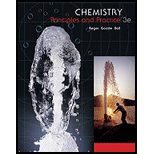
(a)
Interpretation:
Pressure of the container has to be calculated if all the water present in it is vaporized.
(a)
Answer to Problem 11.96QE
The pressure of container that contains
Explanation of Solution
Mass of water present in the container is given as
Therefore, the number of moles present in
The ideal gas equation is given as shown below;
Rearranging the above equation in terms of pressure as follows;
Substituting the values in above equation, the pressure of container can be calculated as shown below;
Therefore, the pressure of container that contains
(b)
Interpretation:
Vapor pressure of water at
(b)
Explanation of Solution
From the table 6.3 present in the book, the vapor pressure of water at
(c)
Interpretation:
Mass of water that evaporates has to be calculated and also the liquid is in equilibrium with vapor in the vessel or not has to be given.
(c)
Answer to Problem 11.96QE
The mass of vaporized water is
Explanation of Solution
Vapor pressure of water is given as
The vapor pressure of water can be converted into
The ideal gas equation is given as shown below;
Rearranging the above equation in terms of number of moles as follows;
Substituting the values in above equation, the number of moles of water can be calculated as shown below;
Therefore, the number of moles of water present in vapor state is
Molar mass of water is
Therefore, the mass of water is
Want to see more full solutions like this?
Chapter 11 Solutions
Chemistry
- 5-106 The normal boiling point of hexane, C6H14, is 69°C, and that of pentane, C5H12, is 36°C. Predict which of these compounds has a higher vapor pressure at 20°C.arrow_forwardWhich would you expect to have the higher fusion enthalpy, N2 or I2? Explain your choice.arrow_forward5-86 Using the phase diagram of water (Figure 5-20), describe the process by which you can sublime 1 g of ice at-10°C and at 1 atm pressure to water vapor at the same temperature.arrow_forward
- In an experiment, 20.00 L of dry nitrogen gas, N2, at 20.0C and 750.0 mmHg is slowly bubbled into water in a flask to determine its vapor pressure (see the figure on next page). The liquid water is weighed before and after the experiment, from which the experimenter determines that it loses 353.6 mg in mass. Answer the following questions. a How many moles of nitrogen were bubbled into the water? b The liquid water diminished by how many moles? What happened to the liquid? c How many moles of gas exit the flask during the experiment? What is the partial pressure of nitrogen gas exiting? The total gas pressure is 750.0 mmHg. d From these data, calculate the vapor pressure of water at 20C. Does this agree with what you expect?arrow_forwardExplain why liquids assume the shape of any container into which they are poured, whereas solids are rigid and retain their shape.arrow_forwardChloroform, CHCl3, has a normal boiling point of 61C. Its vapor pressure at 43C is 0.526 atm. What is the concentration (in g/L) of CHCl3 when it saturates the air at 27C?arrow_forward
- Why do liquids have a vapor pressure? Do all liquids have vapor pressures? Explain. Do solids exhibit vapor pressure? Explain. How does vapor pressure change with changing temperature? Explain.arrow_forwardPredict which liquid—glycerol, HOCH2CH(OH)CH2OH, or hexane, C6H14—has the greater surface tension. Explain your prediction.arrow_forward
 Chemistry: Principles and PracticeChemistryISBN:9780534420123Author:Daniel L. Reger, Scott R. Goode, David W. Ball, Edward MercerPublisher:Cengage Learning
Chemistry: Principles and PracticeChemistryISBN:9780534420123Author:Daniel L. Reger, Scott R. Goode, David W. Ball, Edward MercerPublisher:Cengage Learning
 Chemistry: An Atoms First ApproachChemistryISBN:9781305079243Author:Steven S. Zumdahl, Susan A. ZumdahlPublisher:Cengage Learning
Chemistry: An Atoms First ApproachChemistryISBN:9781305079243Author:Steven S. Zumdahl, Susan A. ZumdahlPublisher:Cengage Learning ChemistryChemistryISBN:9781305957404Author:Steven S. Zumdahl, Susan A. Zumdahl, Donald J. DeCostePublisher:Cengage Learning
ChemistryChemistryISBN:9781305957404Author:Steven S. Zumdahl, Susan A. Zumdahl, Donald J. DeCostePublisher:Cengage Learning Chemistry for Engineering StudentsChemistryISBN:9781337398909Author:Lawrence S. Brown, Tom HolmePublisher:Cengage Learning
Chemistry for Engineering StudentsChemistryISBN:9781337398909Author:Lawrence S. Brown, Tom HolmePublisher:Cengage Learning Introduction to General, Organic and BiochemistryChemistryISBN:9781285869759Author:Frederick A. Bettelheim, William H. Brown, Mary K. Campbell, Shawn O. Farrell, Omar TorresPublisher:Cengage Learning
Introduction to General, Organic and BiochemistryChemistryISBN:9781285869759Author:Frederick A. Bettelheim, William H. Brown, Mary K. Campbell, Shawn O. Farrell, Omar TorresPublisher:Cengage Learning





